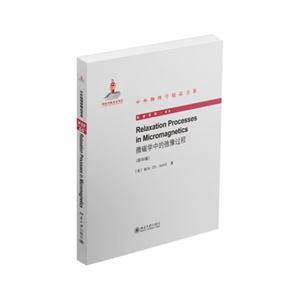掃一掃
關注中圖網
官方微博
本類五星書更多>
-
>
宇宙、量子和人類心靈
-
>
氣候文明史
-
>
南極100天
-
>
考研數學專題練1200題
-
>
希格斯:“上帝粒子”的發明與發現
-
>
神農架疊層石:10多億年前遠古海洋微生物建造的大堡礁
-
>
聲音簡史
微磁學中的弛豫過程-(影印版) 版權信息
- ISBN:9787301251874
- 條形碼:9787301251874 ; 978-7-301-25187-4
- 裝幀:一般膠版紙
- 冊數:暫無
- 重量:暫無
- 所屬分類:>
微磁學中的弛豫過程-(影印版) 本書特色
《微磁學中的弛豫過程(英文影印版)》講述了微磁學的相關概念。特別地,本書對弛豫過程中的一些現象進行了深入探討。并且,本書對弛豫的理論分析也給與了詳細介紹。本書適合凝聚態物理、固體物理和材料物理領域的研究者參考。
微磁學中的弛豫過程-(影印版) 內容簡介
弛豫過程是普遍存在與物理現象中的。在微磁學中,弛豫過程更是必須考慮的對象。國內系統講述這方面理論的圖書非常罕見,《微磁學中的弛豫過程(英文影印版)》的引進對國內的相關研究人員會很有幫助。
微磁學中的弛豫過程-(影印版) 目錄
preface vii
notations and conventions xvii
1 the classical magnetization field
1.1 introduction
1.2 equations of motion
1.2.1 damping
1.3 approaching the curie temperature
2 small motions of the magnetization
2.1 introduction
2.2 models of small motions
2.2.1 distributive damping
2.2.2 instabilities and spin wave condensates
3 intrinsic damping
3.1 introduction
3.2 magnetostrictive coupling
3.2.1 small samples
3.2.2 large, homogeneous samples
3.3 loss torque in magnetic metals
3.3.1 eddy current damping
3.3.2 direct coupling of conduction electrons to the
magnetization field
3.4 fluctuations in medium properties
3.5 relaxation due to weakly coupled magnetic impurities
3.5.1 slow relaxation
3.5.2 corrections to the adiabatic limit
3.6 appendix 3a. inclusion of displacement current in
section 3.3.1
4 fluctuations
4.1 introduction
4.2 fluctuation-dissipation theorem
4.3 langevin equation, and generalized langevin equation
4.4 fokker-planck equation-cartesians
4.4.1 fokker-planck equation in polar angles
4.4.2 fokker-planck equation in the absence of well-defined
canonical variables
5 magnetization reversal in a very dilute array of small
particles
5.1 introduction
5.2 general observations
5.3 reversal in 2d
5.3.1 reversal in the long time limit
5.3.2 intermediate time scales
5.3.3 applied field and anisotropy axis misaligned
5.3.4 relation to first-passage type theories
5.4 rotation in 3d
6 magnetization reversal in arrays of particles and
continuous media
6.1 introduction
6.2 relaxation due to magnetic moment interaction in
a sparse medium
6.2.1 equations of motion for dipolar interaction
6.2.2 a single pair
6.3 more dense arrays of many interacting particles
6.3.1 the arnold web
6.3.2 relevance to magnetic relaxation and reversal
6.3.3 effective single-variable relaxation from causes other than
chaos
6.4 magnetization reversal and the magnetization process in
large, dense systems
6.4.1 simple model of magnetization reversal by domain wall
motion
6.4.2 motion of a bloch domain wall
6.4.3 magnetostatics and the magnetization process.
pre-existing domain walls
6.5 appendix 6a: vortex solutions in cylinder and disc: stability
considerations
references
subject index
notations and conventions xvii
1 the classical magnetization field
1.1 introduction
1.2 equations of motion
1.2.1 damping
1.3 approaching the curie temperature
2 small motions of the magnetization
2.1 introduction
2.2 models of small motions
2.2.1 distributive damping
2.2.2 instabilities and spin wave condensates
3 intrinsic damping
3.1 introduction
3.2 magnetostrictive coupling
3.2.1 small samples
3.2.2 large, homogeneous samples
3.3 loss torque in magnetic metals
3.3.1 eddy current damping
3.3.2 direct coupling of conduction electrons to the
magnetization field
3.4 fluctuations in medium properties
3.5 relaxation due to weakly coupled magnetic impurities
3.5.1 slow relaxation
3.5.2 corrections to the adiabatic limit
3.6 appendix 3a. inclusion of displacement current in
section 3.3.1
4 fluctuations
4.1 introduction
4.2 fluctuation-dissipation theorem
4.3 langevin equation, and generalized langevin equation
4.4 fokker-planck equation-cartesians
4.4.1 fokker-planck equation in polar angles
4.4.2 fokker-planck equation in the absence of well-defined
canonical variables
5 magnetization reversal in a very dilute array of small
particles
5.1 introduction
5.2 general observations
5.3 reversal in 2d
5.3.1 reversal in the long time limit
5.3.2 intermediate time scales
5.3.3 applied field and anisotropy axis misaligned
5.3.4 relation to first-passage type theories
5.4 rotation in 3d
6 magnetization reversal in arrays of particles and
continuous media
6.1 introduction
6.2 relaxation due to magnetic moment interaction in
a sparse medium
6.2.1 equations of motion for dipolar interaction
6.2.2 a single pair
6.3 more dense arrays of many interacting particles
6.3.1 the arnold web
6.3.2 relevance to magnetic relaxation and reversal
6.3.3 effective single-variable relaxation from causes other than
chaos
6.4 magnetization reversal and the magnetization process in
large, dense systems
6.4.1 simple model of magnetization reversal by domain wall
motion
6.4.2 motion of a bloch domain wall
6.4.3 magnetostatics and the magnetization process.
pre-existing domain walls
6.5 appendix 6a: vortex solutions in cylinder and disc: stability
considerations
references
subject index
展開全部
書友推薦
- >
企鵝口袋書系列·偉大的思想20:論自然選擇(英漢雙語)
- >
隨園食單
- >
姑媽的寶刀
- >
月亮虎
- >
莉莉和章魚
- >
名家帶你讀魯迅:故事新編
- >
經典常談
- >
我從未如此眷戀人間
本類暢銷
















